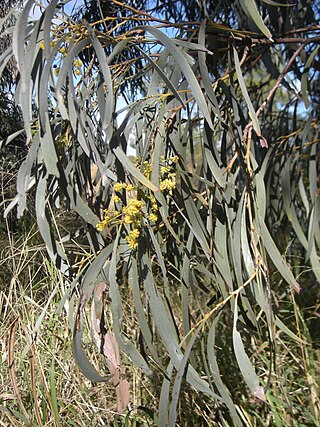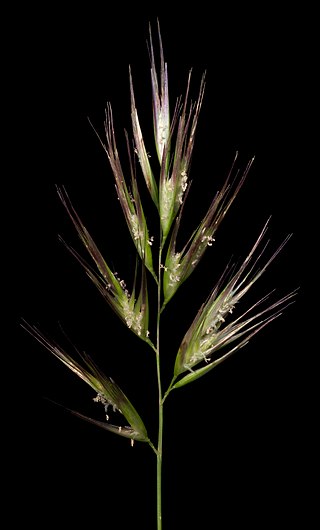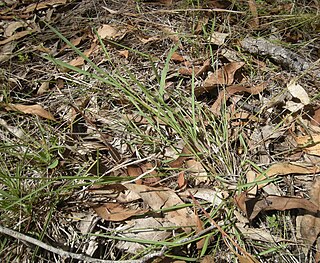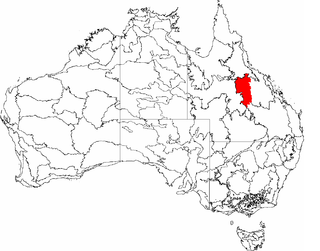Related Research Articles
Bendidee is a national park in the Goondiwindi Region, Queensland, Australia.
Taunton National Park is situated near the town of Dingo approximately 135 km inland from Rockhampton in eastern Central Queensland, Australia. The park encompasses an area of 11,626 ha within the Northern Brigalow Belt bioregion of Queensland; a region widely recognised to contain considerable biodiversity.

Paspalum is a genus of plants in the grass family.

Echinochloa is a very widespread genus of plants in the grass family and tribe Paniceae. Some of the species are known by the common names barnyard grass or cockspur grass.

Acacia harpophylla, commonly known as brigalow, brigalow spearwood or orkor, is an endemic tree of Australia. The Aboriginal Australian group the Gamilaraay peoples know the tree as Barranbaa or Burrii. It is found in central and coastal Queensland to northern New South Wales. It can reach up to 25 m (82 ft) tall and forms extensive open-forest communities on clay soils.

Acacia cambagei, commonly known as gidgee, stinking wattle, stinking gidgee in English, or gidjiirr, by transliteration from indigenous languages of north-western NSW, is an endemic tree of Australia. It is found primarily in semiarid and arid Queensland, but extends into the Northern Territory, South Australia and north-western New South Wales. It can reach up to 12 m in height and can form extensive open woodland communities. The leaves, bark, and litter of A. cambagei produce a characteristic odour, vaguely reminiscent of boiled cabbage, gas or sewage that accounts for the common name of "stinking gidgee".
Goonderoo Reserve is a 593–hectare nature reserve in the Brigalow belt of Queensland, Australia. It is located 40 km south of Emerald, 300 km west of Rockhampton and 835 km north-west of Brisbane. It is owned and managed by Bush Heritage Australia (BHA), by which it was purchased in 1998.

Rytidosperma caespitosum, known by various common names including common wallaby-grass, ringed wallaby-grass, and white-top, is a species of grass native to southern parts of Australia.

Brigalow is a rural town and locality in the Western Downs Region, Queensland, Australia. In the 2016 census the locality of Brigalow had a population of 170 people.

The Brigalow Belt is a wide band of acacia-wooded grassland that runs between tropical rainforest of the coast and the semi-arid interior of Queensland and northern New South Wales, Australia. The Interim Biogeographic Regionalisation for Australia (IBRA) divides the Brigalow Belt into two IBRA regions, or bioregions, Brigalow Belt North (BBN) and Brigalow Belt South (BBS). The North and South Brigalow Belt are two of the 85 bioregions across Australia and the 15 bioregions in Queensland. Together they form most of the Brigalow tropical savanna ecoregion.

Paspalidium(watercrown grass) is a genus of tropical and subtropical plants in the grass family.

Rytidosperma is a genus of plants in the grass family. Most of the species occur in Australasia, with a few in insular Southeast Asia, southern South America, and certain islands of the Pacific. Several are known by the general common name wallaby grass.

The Mulga Lands are an interim Australian bioregion of eastern Australia consisting of dry sandy plains with low mulga woodlands and shrublands that are dominated by Acacia aneura (mulga). The Eastern Australia mulga shrublands ecoregion is coterminous with the Mulga Lands bioregion.

The Southeast Australia temperate savanna ecoregion is a large area of grassland dotted with eucalyptus trees running north–south across central New South Wales, Australia.

Acacia argyrodendron, known colloquially as black gidyea or blackwood, is a species of Acacia native to Australia. Czech botanist Karel Domin described this species in 1926 and it still bears its original name. Domin reported collecting the type specimen from somewhere between Camooweal and Burketown in northwestern Queensland, though it is more likely to have been northeast of Aramac.

The Desert Uplands is an interim Australian bioregion located in north and central western Queensland which straddles the Great Dividing Range between Blackall and Pentland.
Mount Darry is a rural locality in the Toowoomba Region, Queensland, Australia. In the 2016 census Mount Darry had a population of 35 people.

The Mitchell Grass Downs is a tropical and subtropical grasslands, savannas, and shrublands ecoregion in northeastern Australia. It is a mostly treeless grassland, characterised by Mitchell grasses .
Paspalidium basicladum is a species of grass in the family Poaceae native to Australia, first described by Dorothy Kate Hughes in 1923. It is an annual and is found in desert and dry shrublands. Australian authorities accept the name as Paspalidium basicladum, but other authorities consider the accepted name to be Setaria basiclada.
References
- ↑ S. W. L. Jacobs & C. A. Wall. "New South Wales Flora Online: Paspalidium caespitosum". Royal Botanic Gardens & Domain Trust, Sydney, Australia.